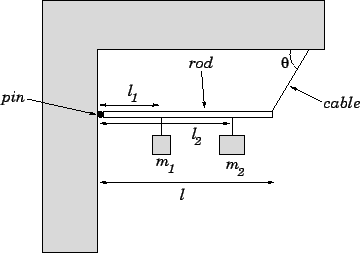

Answer: Consider the torque acting on the rod about the pin. Note that the
reaction at the pin makes no contribution to this torque (since the
length of the associated lever arm is zero).
The torque due to the
weight of the rod is ![]() (i.e., the weight times the length of the lever arm).
Note that the weight of the rod acts at its centre of mass, which is located at the
rod's mid-point.
The torque due to the weight of the first mass is
(i.e., the weight times the length of the lever arm).
Note that the weight of the rod acts at its centre of mass, which is located at the
rod's mid-point.
The torque due to the weight of the first mass is
![]() .
The torque due to the weight of the second mass is
.
The torque due to the weight of the second mass is ![]() .
Finally, the torque due to the tension in the cable is
.
Finally, the torque due to the tension in the cable is
![]() (this
torque is negative since it twists the rod in the opposite sense to the
other three torques).
Hence, setting the net torque to zero, we obtain
(this
torque is negative since it twists the rod in the opposite sense to the
other three torques).
Hence, setting the net torque to zero, we obtain
![$\displaystyle \frac{ [m/2 + m_1 (l_1/l) + m_2 (l_2/l)] g }{\sin\theta}$](img1727.png) |
|||
![$\displaystyle \frac{[0.5\times 15 + 36\times(0.5/3)+24\times(2.3/3)]\times 9.81}{\sin 40^\circ}$](img1728.png) |
|||